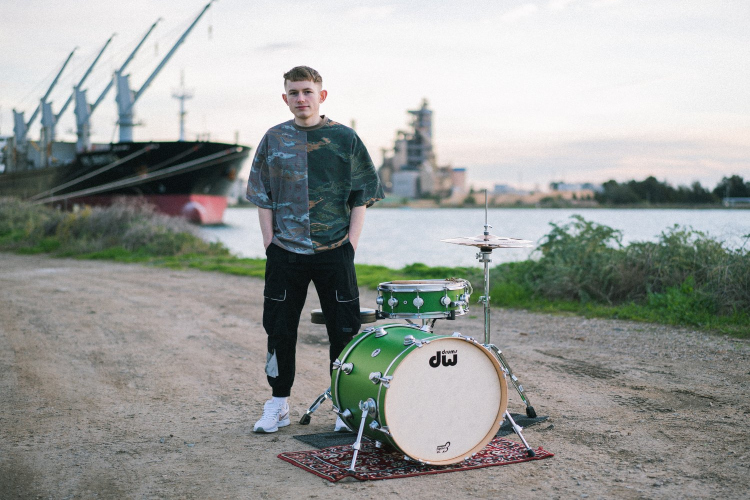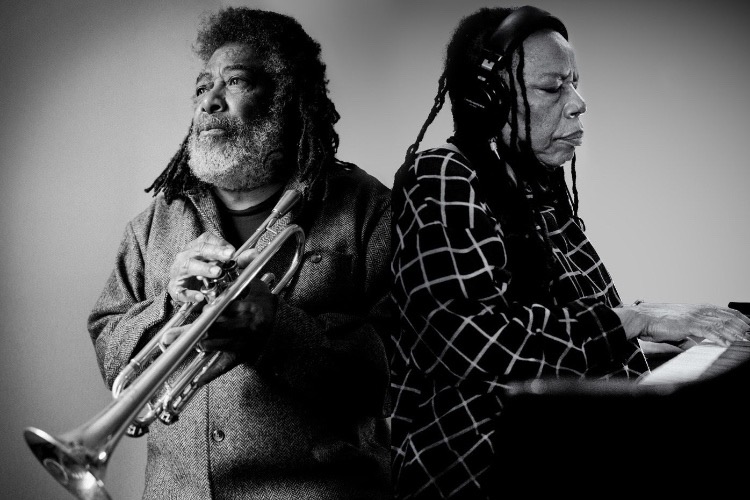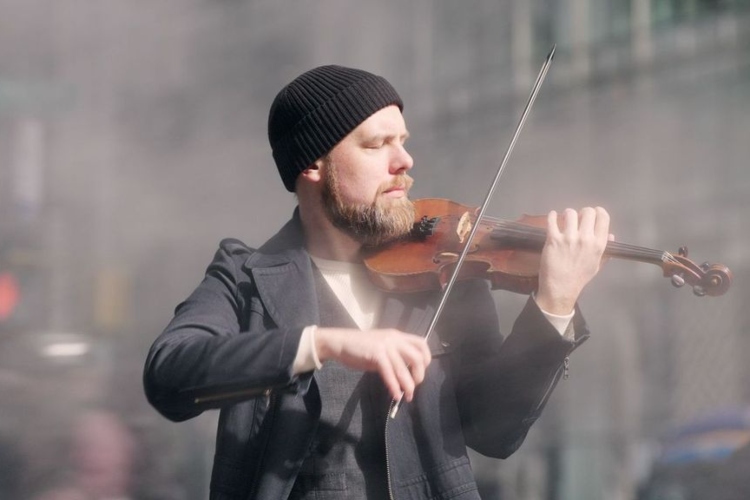Bridging the Space Between: A Conversation with Alexander Flood
|
Getting your Trinity Audio player ready...
|
One can summarize much of the COVID-19 pandemic in one word: isolation. Travel restrictions made walls between countries seem higher. Shutdowns and social distancing only further underscored divides within local communities. And quarantine itself was the direct removal of individuals from those around them. With this backdrop, South Australian drummer Alexander Flood’s latest, The Space Between (Stretch Music/Ropeadope, 2022) is a breath of fresh air.
Instead of emphasizing divisions, The Space Between hones in on our commonalities by using music as a cross-cultural means of communication. While HEARTBEAT (Stretch Music/Ropeadope, 2020) touched on these themes, this new release goes deeper. Modern dance music and traditional sounds from the Middle East, North Africa, West Africa, India, and Southeast Asia are treated less as segmented categories and more like different colors in a sunset. One fades imperceptibly into another. While you can tell there is beauty present, you can’t always clearly distinguish a specific hue.
We caught up with Flood to discuss the new album, how it came together, and how it compares to its predecessor.
PostGenre: When we last spoke, you were planning to go on tour to promote HEARTBEAT. With the pandemic and everything else, did you end up touring?
Alexander Flood: I was able to do a few shows in Australia and have a couple more Australian dates scheduled for later this year. But I want to take my music overseas. Taking this music abroad is something I’m working towards, specifically Europe, then hopefully the US at some stage too.
PG: Would your performances be more like the music on HEARTBEAT, The Space Between, or something else entirely?
AF: A lot of the tunes on HEARTBEAT came from jams and more open-form riffs, so presenting that music live was in some ways a little more complicated. The new songs are more adaptable to live playing because they’re more structured compositions and arranged in a way that is more easily reproducible in the moment but still flexible and open for changing things up. The instrumentation of this new record also works in favor of live performance, as the core of a lot of it is drums, Rhodes, bass, and percussion. I’m starting to write new music now too, so this will be fun to try out in a show.
PG: Is that what you feel most sets The Space Between apart from Heartbeat, that it is more structured?
AF: HEARTBEAT was more of an experiment. At times I threw together ideas to see what came of them. This led to some super-diverse approaches throughout that album. With The Space Between, I think I’m finally finding my voice as a composer and a bandleader. To me, The Space Between feels more musically cohesive, structured, and more thoroughly arranged. The songs are meticulously pieced together. This was a much bigger album to work on, and I’ve grown, as has my music.
I think both projects are very different documents of music and not something that you can easily compare. But the songs on The Space Between flow together stylistically and complement one another. On the first album, there was a lot of movement between tracks. You had a more Afrobeat-influenced track, followed by one inspired by Hindustani classical music or electronic music.
PG: The music on HEARTBEAT was, to some extent, more compartmentalized.
AF: Exactly. Whereas this new album is a bit more integrated. The influences are more woven together. And part of that comes from how meticulously I built the compositions. A lot of my composing before this album has been jam-like, with everything established loosely around a central riff. But with this project, I wanted more concrete songs that could stand up on their own. I wanted a bit more substance and variety between sections. I wanted music that felt more fully fleshed out and arranged; music that I could write down and make sense of as a chart.
PG: Although more structured, as The Space Between was your second album as a leader, do you feel you could take more risks than on your first?
AF: I think so. There was never any point with either recording that I felt boxed into a specific idea or sound. I retained complete control over the music on both albums. That’s part of what I love so much about working with Ropeadope. The label is very open-minded and ready to welcome whatever artists are trying to create. The Ropeadope team is very happy to foster our creativity.
PG: On this album, as on the last one, the music reflects influences from traditional music from around the globe. But this time, there were also more electronic influences.
AF: Yes, there are a lot of contemporary sounds along with the more traditional global ones. Dance music influenced much of the album, both rhythm and harmony. I do love all things house, UKG, broken beat, jungle, etc. Part of my intent with bringing dance music into the album was to try to draw connections between the present and the past. Throughout history and across different cultures and styles, supporting dance has been a common and significant function of music. Music and dance have always been so interwoven. Much of the music from places like West Africa has an inherent dance component to it. I wanted to play on that idea and create music that leaned on modern dance music to bridge those connections.
PG: Christian Scott aTunde Adjuah also extensively studies those connections between the past and present in his music. Christian worked with you on HEARTBEAT, but “Pathways” is the first recording of the two of you performing together, correct?
AF: That’s right.
PG: What was it like performing with him compared to how you worked with him on the last album?
AF: Ever since I first met Christian, he has always been incredibly generous with his time, energy, resources, and knowledge. Whether a business-related discussion, something specific about music, or just chatting, he always gives his all. He always gives everything he can to help you learn and grow. Having him on the actual record is very special to me. I still remember the exact moment I first discovered his music – it was the red album cover of Stretch Music (Ropeadope, 2015). It’s very cool to now have him as part of my music.
PG: In terms of the more traditional sounds, on three tracks, Zhao Liang joins on the guzheng and, on two, Wei-Han Dai plays the erhu. What led you to include traditional Chinese instrumentation on the album?
AF: I wrote the vast majority, maybe 90%, of the music for HEARTBEAT about a year before I lived overseas. But most of the music on The Space Between I wrote after I spent a year traveling the world as part of a tour.
During that year, we did some shows in Shanghai, China. We were there for about three weeks, including over my birthday that year. On my birthday, I decided to check out Jinling Road, a street lined with music shops. There are hundreds of stores – piano shops, drum shops, traditional Chinese instrument shops, record stores, and music schools – all on this one street. I went into a few of the traditional Chinese instrument stores and saw some beautiful instruments that I had never seen before. The owner of one of the stores sat and played the erhu violin. Further down the road, someone else gave guzheng lessons right on the sidewalk in front of a store. The sounds of both instruments stuck around in my head, and I knew I wanted to draw upon these kinds of emotive strings and beautiful textures when writing for The Space Between.
Jumping forward to 2021, I was doing a Chinese New Year concert as part of a large ensemble at the Chinese School of Music and Art here in South Australia. As part of that performance, I met the founder of the school, Zhao Liang. I also met Wei-Han Dai. I ended up asking them both to add to my album, on the guzheng and erhu respectively.
PG: There is also a Middle Eastern influence on “Kantra” with Zayn Mohammad on oud. How did that come together?
AF: Zayn is a very talented multi-instrumentalist based in London. On this track, he’s playing in a style that borrows from Turkish music. The track’s title comes from an Arabic word for “Bridge.” Zayn and I spent a lot of time discussing what the track represents. We concluded that it’s really about bridging ideas. By combining the Turkish influences with rhythms from the Maghreb region of North Africa, Egypt, and Zayn’s Indian heritage, we were bridging these cultures together. This was a difficult track to put together, but it was a great challenge for us, and I had a lot of fun collaborating with Zayn.
PG: Speaking of challenges, was it difficult for you to write parts for instruments that don’t necessarily use Western notation for most of their music?
AF: Well, each of the feature artists I worked with composed their own melody parts. I wanted to give them as much creative license and freedom as possible. This was also so we could spotlight their unique voice and approach to the music.
Zayn wrote his part. I wouldn’t have felt comfortable writing for the oud. We still shared ideas, which helped sharpen the direction. But Zayn ultimately wrote the lead melody and improvised the solo.
The features aren’t only instrumental. For example, “Starseed” features vocalist Vivian Sessoms. I wrote the whole track with her in mind, and once we had a full demo of all the rhythm section parts, I sent it to her and gave her full creative freedom to write over the top.
PG: Max Roach once said, “when you think about the drum set, it is pretty wild. You look at the snare drum and the bass drum, and they’re from Europe. You look at the toms, and they are African drums. If you look at the cymbals, they’re from Asia.” Do you feel that being a percussionist puts you in a unique position to bridge cultures?
AF: It’s impossible to say as a blanket statement that the drum is better than any other instrument in bridging cultural divides, but I think drums have a unique way of bringing people together. Membranophones are such global instruments and concepts. Drums have existed in almost all cultures for almost the entirety of human history. The drum has become such a relatable instrument to people from all around the world. Everyone knows how a drum works, at least in its simplest form. So, it does seem that the drum is a great way to start a conversation about different cultures, styles, identities, etc. It’s a way to draw people together with a common ground relatable to all parties. The drum is a great bridge between people.
PG: Is there a culture whose music you desire to explore but have not yet?
AF: Absolutely. There are hundreds, if not thousands of different cultures, each with their own ethnic groups, languages, religions, and music. I feel as though I’ve only really scratched the surface in discovering and studying these different forms of music, but my passion and hunger for learning will always keep me wanting more.
PG: It is still difficult to learn about these cultures, even with the internet making information so widely available?
AF: It is. Sure, a lot of information is available, but sometimes it’s impossible to know a source’s reliability or factuality. Often, people are the most valuable resources, and their own experiences and perspectives can provide a better education than reading a book. I’m always on the hunt for published ethnomusicology papers and books. I’ve been meaning to visit the State Library here and see what I can dig up. But so much of my learning comes through listening and digesting these things sonically. Outside of Western music, so much music is taught aurally and has been for thousands of years. Aural dissemination of information, even today, is such a vital part of the human experience and a critical part of studying music.
‘The Space Between’ is now available on Stretch Music/Ropeadope. It can be purchased on Bandcamp.
More information on Alexander Flood can be found on his website.




One thought on “Bridging the Space Between: A Conversation with Alexander Flood”